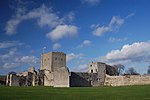Portus Adurni
Anglo-Saxon sites in EnglandArchaeological sites in HampshireBuildings and structures completed in the 3rd centuryEnglish Heritage sites in HampshireRoman fortifications in England ... and 3 more
Saxon Shore fortsStanding Anglo-Saxon buildingsTourist attractions in Hampshire

Portus Adurni was a Roman fort in the Roman province of Britannia situated at the north end of Portsmouth Harbour. It was part of the Saxon Shore, and is the best-preserved Roman fort north of the Alps. Around an eighth of the fort has been excavated.It was later converted into a medieval castle known as Portchester Castle.
Excerpt from the Wikipedia article Portus Adurni (License: CC BY-SA 3.0, Authors, Images).Portus Adurni
Castle Street,
Geographical coordinates (GPS) Address Website Nearby Places Show on map
Geographical coordinates (GPS)
| Latitude | Longitude |
|---|---|
| N 50.838055555556 ° | E -1.115 ° |
Address
Portchester Castle
Castle Street
PO16 9QL , Portchester
England, United Kingdom
Open on Google Maps






